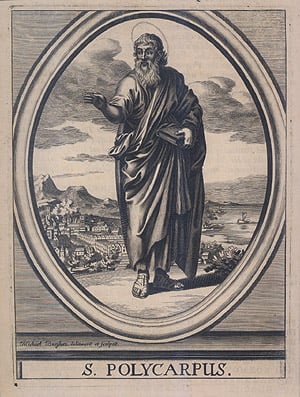Apostolic Fathers
| Part of a series of articles on Christianity | ||||||

| ||||||
|
Foundations Bible Christian theology History and traditions
Topics in Christianity Important figures | ||||||
|
Christianity Portal | ||||||
The Apostolic Fathers is a small collection of Christian writings from the second half of the first century C.E. and the first half of the second century C.E. Its authors are acknowledged as leaders in the early church, but their whose writings were not included in the New Testament Biblical canon, at least as finalized in Roman Catholicism, Eastern Orthodoxy, and Protestant Christianity.
The term “Apostolic Fathers,” has been used since the seventeenth century to emphasize that these authors were thought of as being of the generation that had personal contact with the Apostles. Thus they provide a link between the Apostles who knew Jesus of Nazareth and the later generation of Christian apologists and defenders of orthodox authority and developers of doctrine: the Church Fathers.
Definition of terms
The "Apostolic Fathers," as persons, are distinguished from other Christian (or semi-Christian) authors of this same period in that their practices and theology largely fell within those developing traditions of orthodox Pauline Christianity that became the mainstream. By the fourth century, mainstream Nicene Christianity was in a position to use the power of the Roman state in declaring significantly different interpretations as heretical. Other early, but not "apostolic" Christian-oriented writings were actively denounced and suppressed in the following centuries and many are now "lost" works.
The writings of the Apostolic Fathers are in a number of genres, some, e.g. the writings of Clement of Rome and Ignatius of Antioch are letters; others relate supposedly historical events, e.g. the Martyrdom of Polycarp, one (the Shepherd of Hermas) is a book of prophecy; and one (the Didache) is a guide for ethical and liturgical practice.
Contemporary non-apostolic works
The extant writings from the early Christian tradition that are not classed in those of the Apostolic Fathers include the apocryphal gospels), much of the pseudepigrapha, and the writings of unorthodox leaders or heretics. Much of this literature was intentionally destroyed by church authorities, although some fragments survived in the writings of orthodox teachers who quoted heretical writers in order to refute them. Most of the apocryphal gospels and pseudepigrapha are, however, somewhat later writings than the Apostolic Fathers. A number of the New Testament Apocrypha were discovered throughout the centuries, and a major the discovery, known as the Nag Hammadi library, was unearthed in the mid twentieth century in Egypt.
Although a few of the opinions expounded by the Apostolic Fathers are no longer considered entirely orthodox, their writings provide important evidence for the "proto-orthodox" strain of early Christianity, as well as its intellectual history.
Shortly after the time of the Apostolic Fathers, several Christian authors addressed their works to people beyond the Christian community (and sometimes to fellow Christians) and defended the Christian religion against paganism, including Justin Martyr, Irenaeus, and Tertullian. These are considered Apologists. A number of other authors, now only known in fragments, such as Papias and Hegesippus, were more exclusively concerned with the apostolic continuity of the individual churches and their histories.
Inclusion on list
The list of Apostolic Fathers has varied. Inclusion is based striclty on church tradition, but literary criticism resulted in the removal of some writings formerly considered as second century. Of all the writings rediscovered in the modern era, only the Didache, discovered in the 1880s, has been added to the list. Chief in importance, according to the Catholic Encyclopedia, are three 1st-century Bishops:
- St. Clement of Rome. Clement, third successor to St. Peter as Bishop of Rome, "had seen the blessed Apostles [Peter and Paul] and had been conversant with them" (Irenaeus, Adversus Haereses, III, iii, 3).
- St. Ignatius of Antioch. Ignatius was the second successor of St. Peter in the See of Antioch (Eusebius, Hist. Eccl., III, 36) and during his life in that center of Christian activity may have met with others of the Apostolic band. An accepted tradition, substantiated by the similarity of Ignatius's thought with the ideas of the Johannine writings, declares him a disciple of St. John.
- St. Polycarp of Smyrna, of whose intimate personal relations with the Apostles there is the strongest Church tradition. Polycarp was "instructed by Apostles" (Irenaeus, op. cit., III, iii, 4) and had been a disciple of St. John (Eusebius, op. cit., III, 36; V, 20) whose contemporary he was for nearly twenty years.
- St. Papias would certainly have been one of this group, if his work had not been inexplicably lost.
External links
- The Apostolic Fathers - Retrieved September 21, 2007.
- Apostolic Fathers - Retrieved September 21, 2007.
- Apostolic Fathers - Retrieved September 21, 2007.
Credits
New World Encyclopedia writers and editors rewrote and completed the Wikipedia article in accordance with New World Encyclopedia standards. This article abides by terms of the Creative Commons CC-by-sa 3.0 License (CC-by-sa), which may be used and disseminated with proper attribution. Credit is due under the terms of this license that can reference both the New World Encyclopedia contributors and the selfless volunteer contributors of the Wikimedia Foundation. To cite this article click here for a list of acceptable citing formats.The history of earlier contributions by wikipedians is accessible to researchers here:
The history of this article since it was imported to New World Encyclopedia:
Note: Some restrictions may apply to use of individual images which are separately licensed.
